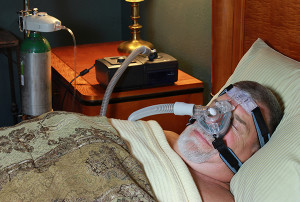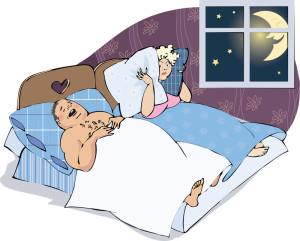Try These Snoring Solutions for a Better Night’s Sleep
CPAP or CPAP alternatives may be the ticket to help you breathe better at night.
If you know you snore and you want a better response than your bed partner’s nudge in the ribs, there are plenty of effective snoring solutions you should consider. If the snoring is due to a potentially dangerous condition known as obstructive sleep apnea (OSA), one of your first considerations should be continuous positive airway pressure (CPAP) or one of the newer CPAP alternatives on the market.
Snoring Causes
An estimated 90 million adults in the U.S. snore from time to time. About a third of them snore on a regular basis. Snoring is simply the result of the walls of your throat vibrating as you inhale and exhale during sleep.
The relaxation of the muscles in your throat, tongue, and the roof of your mouth (soft palette) is typically the cause of snoring. But other factors can also contribute to the frequency and intensity of your snoring. These include the anatomy of your mouth and sinuses. A thicker palette or a deviated nasal septum could be to blame.
Congestion can also affect airflow while you sleep. The path of air in and out of your lungs may also be influenced by your sleep position; lying on your back increases the likelihood that tissue in your throat will “sink” due to gravity, restricting airflow. Alcohol can also make the muscles involved in snoring relax even more than usual during sleep.
And if your snoring is interrupted by pauses in breathing, you may have OSA. If that’s the case, it’s even more urgent that you investigate snoring solutions and remedies for your condition.

Alternatives to full-face CPAP mask now include a nose-only device, which is supposedly less intrusive.
Treating OSA
The “gold standard” for OSA is CPAP. This widely used therapy involves a machine that pumps air through a tube and into a lightweight mask worn over the nose and mouth while you sleep.
But like all snoring solutions, CPAP isn’t right for everyone. For some, the mask and tube may be too cumbersome or noisy. Others may have better outcomes with CPAP alternatives. But if you have a thorough sleep study and your doctor recommends CPAP, you should consider giving it a try, with the understanding that some CPAP alternatives may serve you better.
CPAP Alternatives
For severe snoring associated with OSA, surgery may be useful to reduce excess tissue in the upper airway.
While surgical procedures increase the size of the airway, making breathing easier and reducing snoring, none are without risks. These CPAP alternatives may not be completely successful, and in some cases they may even leave you worse off than before surgery. The success rate for surgery in treating apnea is about 40 percent, depending on the type of surgery and the criteria for success.
Among the snoring solutions your doctor may consider are:
- UPPP: One of the most common procedures is called uvulopalatopharyngoplasty (remember that spelling for your favorite word game!). Better known as UPPP, this surgery involves cutting away part of the uvula, soft palate, tonsils, and other excess tissue in the throat. UPPP requires general anesthesia and an overnight hospital stay. An outpatient procedure, laser-assisted uvulopalatoplasty (LAUP), uses a laser to eliminate excess tissue in the back of the throat. UPPP and LAUP may reduce or eliminate obstructive sleep apnea, but it’s difficult to predict whether either procedure will be effective, and their long-term side effects and benefits are unknown. In addition, one LAUP procedure may not be sufficient to address the breathing problem.
- Ablation high frequency radio wave ablation: This CPAP alternative is a newer procedure that uses radiofrequency energy from a specially designed probe to generate heat to shrink the size of structures in the upper airway, including the uvula and the base of the tongue. The heat is delivered to the tissues beneath the mucous membrane, so patients experience much less post-operative discomfort than with UPPP or LAUP. High-frequency radio wave ablation is not yet approved as a treatment for sleep apnea; it’s used primarily for snoring. Insurance or Medicare may not cover these surgeries, and with any of these procedures, a follow-up sleep study is needed to assess whether apnea has improved.
- Pillar procedure: The FDA approved the first implant to treat sleep apnea in 2004. The Pillar Procedure (previously approved to treat snoring) involves placing three small woven-polyester inserts into the soft palate at the back of the roof of the mouth. The inserts stiffen the palate to prevent the tissues from collapsing during sleep and blocking breathing. The soft palate implant is inserted in a doctor’s office under local anesthetic.
Simpler Snoring Solutions
If your snoring is milder or less frequent than someone with OSA, you may want to try a few less-invasive options, such as:
- Losing weight, especially in the circumference of the neck, can improve respiration while sleeping. (See our post “Best Weight-Loss Tips: 5 to Remember.”)
- Lie on your side. This helps prevent the problem faced by people who snore more when lying on their back.
- Avoid alcohol consumption in the evening.
- Treat allergies or chronic congestion to help clear your air passages.
- Use nasal strips that help widen your nose’s air passages.

One way to potentially alleviate snoring is to lose weight; less fatty tissue around the neck area may make a difference.
If snoring is waking you up or keeping your partner up all night, don’t hesitate to see a physician. It may seem like a minor annoyance, but snoring can keep you from getting a restful sleep, and the health problems associated with poor sleep, and especially OSA, can be a real nightmare.
Effective snoring solutions are out there. It may take a little trial and error, but with some effort you and your partner may be sleeping peacefully before you know it.
Originally published in April 2016 and updated.


 Look Beyond the Scale
Look Beyond the Scale  Weighted Blanket Benefits
Weighted Blanket Benefits  How to Sleep With Sciatica
How to Sleep With Sciatica 
Snoring may not only keep your partner awake, but it may prevent you from a restful sleep. It also may signal such health problems as sleep apnea.
© Wavebreakmedia Ltd | Dreamstime.com